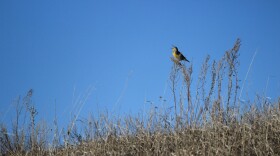Most North Dakotans are familiar with the great horned owl. But I suspect few are familiar with the short-eared owl — even though, of the half-dozen or so owls native to the state, the short-eared owl is most closely associated with the wide open spaces of North Dakota prairie.
Short-eared owls are a little smaller than great horned owls. And unlike the great horned owls, they are not very vocal. They are a mottled brown, with some tawny and white, and their undersides are whiteish with brown streaks. The head is rounded, and the face is light-colored with dark eye patches and bright yellow eyes with black pupils. The ear tufts are small, and rather inconspicuous.
Short-eared owls are owls of open country, particularly grasslands. In North Dakota short-eared owls can be found throughout the state. Range maps for short-eared owls generally show them as permanent residents in an area largely westward from the Dakotas and Nebraska. Their breeding range also includes much of Canada.
Although short-eared owls may be observed on the ground, or perches on a fencepost or tree, they are perhaps most frequently observed flying low across the prairie, particularly during early mornings and evenings. Their flight has been described as bat-like or consisting of unhurried wingbeats. Like other owls, their flight is silent. Some of the wing feathers are modified with small comb-like edges, which eliminates the sounds associated with flight. That helps them remain undetected by their prey, which consists largely of mice and voles.
It might surprise you, but short-eared owls are ground nesters. The nesting site is typically located in dense vegetation in native prairie. They are also known to nest in hay fields and stubble fields. The nest is often constructed in a slight depression and lined with dead grass and other vegetation. The female will lay an average of six eggs and incubate them for about a month. The young will begin to fly about a month after hatching.
—
Further information:
- Short-eared Owl (Cornell University, All About Birds)
- Short-eared Owl (eBird)
- Short-eared Owl (Owl Research Institute)





